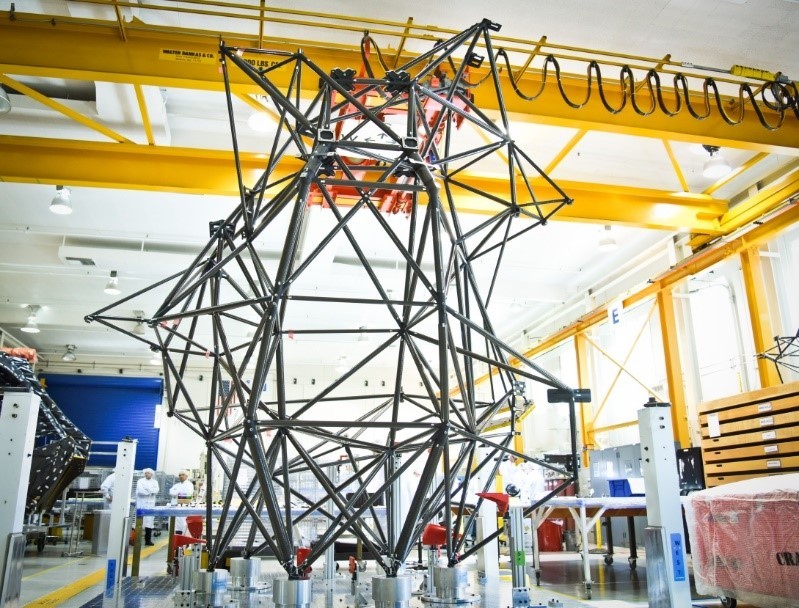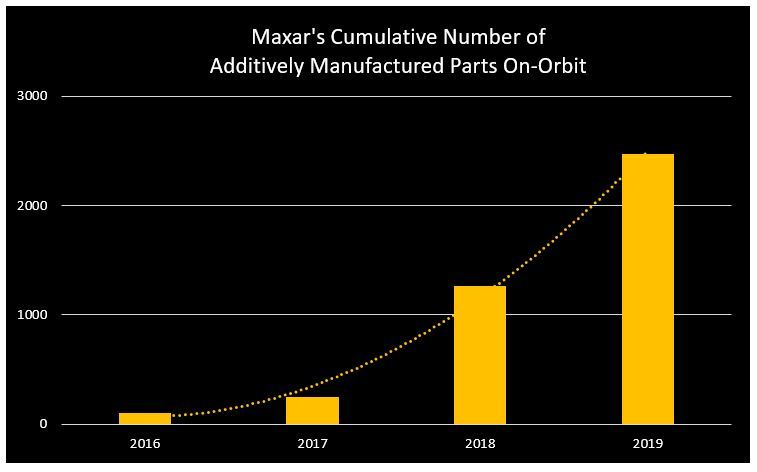As a technological innovator and industry pioneer, Maxar’s experience in using additively manufactured (AM) parts on orbit dates back to 2016. Since then, we have launched 20 spacecraft with parts additively manufactured out of aluminum, titanium, and plastic, totaling more than 2,500 components on-orbit. AM components are now standard for all satellites we build, and we are manufacturing spacecraft today that have well over 1,000 AM parts -- roughly one-third of the number of components in an average spacecraft.

Launched in 2019, the Maxar-built, all-electric EUTELSAT 7C satellite uses nearly 1000 additively manufactured components.
Maxar has unlocked significant benefits through the adoption of AM, including:
- Improved schedule agility: The unique geometries enabled by AM methods allow more efficient design for manufacturing. Maxar has short manufacturing timelines, about two to three years per spacecraft, so any improvement in the schedule is advantageous. For example, composite panel style towers would take five people two to three months to assemble, whereas the strut tower enabled by AM nodes takes two and a half people two to three weeks to assemble. Further manufacturing time savings come from 3D printed tooling that is designed to support the spacecraft during assembly and test, which can remain on the spacecraft when it goes through the arduous thermal vacuum test. During this test, the spacecraft must endure temperatures of up to 176°F and as low as -94°F in an atmosphere without any oxygen –simulating the environment of space. By leaving the support 3D-printed structures on the spacecraft during this test, we eliminate time-intensive removal and reinstallation steps in the build process.
- Reduced manufacturing costs: Bulk printing plastic parts rather than casting or honing leads to less expensive piece-parts. Combining assemblies will reduce part and routing costs. Additional cost reduction comes from reduced time to build and reduced labor hours required. Further, custom AM-tooling enables efficiencies in other non-AM parts and assemblies.
- Increased performance: Every satellite is unique and different, so utilizing AM allows for customized parts with geometries that are specific to each satellite. We are applying AM to combine multiple functions in one flight part, such as having structural components with the ability to accommodate payload capacity. This reduces mass, hardware count, paperwork and part documentation and overall component complexity. On a system level, the mass can be lowered through optimizing the design with the use of geometries that can only be manufactured through 3D printing. By taking advantage of this technology for production, we can improve life on-orbit via lower mass and improved thermal distortion and performance.

The Maxar-built Hispasat 30W-6’s antenna tower was comprised of over 200 additively manufactured parts.

Hispasat 30W-6 before its launch in 2018. The antenna tower, seen at the top of the satellite, is covered with black thermal blanket.
Key to our rapid and early adoption of AM was the establishment of our Additive Center of Excellence in 2012, which validated AM as an innovative and valuable approach for spacecraft manufacturing and identified a process for qualifying AM components for spaceflight. Our extensive process controls, design guides, and material specifications to regulate procurement and production of flight parts, subsequently allowed us to qualify many AM parts and materials for flight on our popular 1300-class spacecraft platform, including Ultem and electrostatic-safe plastics, laser-powder bed fusion of aluminum alloys, and electron beam melted titanium.

We also use AM components for non-flight purposes. For instance, the ability to quickly design and print plastic components has enabled us to prototype designs before settling on a final build. Additionally, by additive manufacturing custom tools and spacecraft support structures, our technicians can work with agility in tight spaces and with sensitive, complex spacecraft components.
Interested in learning more about how Maxar qualifies and uses AM parts? Join me for a discussion on “Additive Manufacturing for Space” together with additive manufacturing company Stratasys this Thursday, July 23 at 10:00 AM CT.